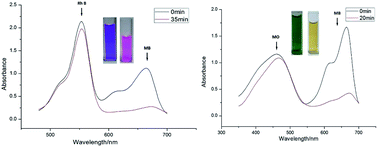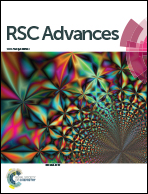Fabrication of a new metal–organic framework for sensitive sensing of nitroaromatics and efficient dye adsorption†
Abstract
The hydrothermal reaction of Cd(II) salt with rigid tetracarboxylate ligand, terphenyl-3,3′′,5,5′′-tetracarboxylic acid (H4L) produced a new metal–organic framework (MOF) {[Cd2(L)(DMF)3]·0.5DMF}n (1). Single crystal X-ray diffraction showed that MOF 1 possesses a 3D microporous framework with 4-connected Dia topology which is based on {Cd2(CO2)4} subunits. MOF 1 is a promising dual functional sensor with high selectivity and sensitivity for the detection and recognition of nitroaromatics (NACs) and Fe3+ ions via alleviation of its fluorescence intensity. Furthermore, 1 also has an excellent capacity to adsorb methylene blue (MB) with high selectivity, and it retains almost similar adsorption performance after being recycled several times. The observed decrease in fluorescence intensity of 1 in the presence of NACs has been addressed by theoretical calculations which indicate that the intensity alleviation of 1 in the presence of NACs can be attributed to an electron and resonance energy transfer between 1 and nitro analytes.



 Please wait while we load your content...
Please wait while we load your content...